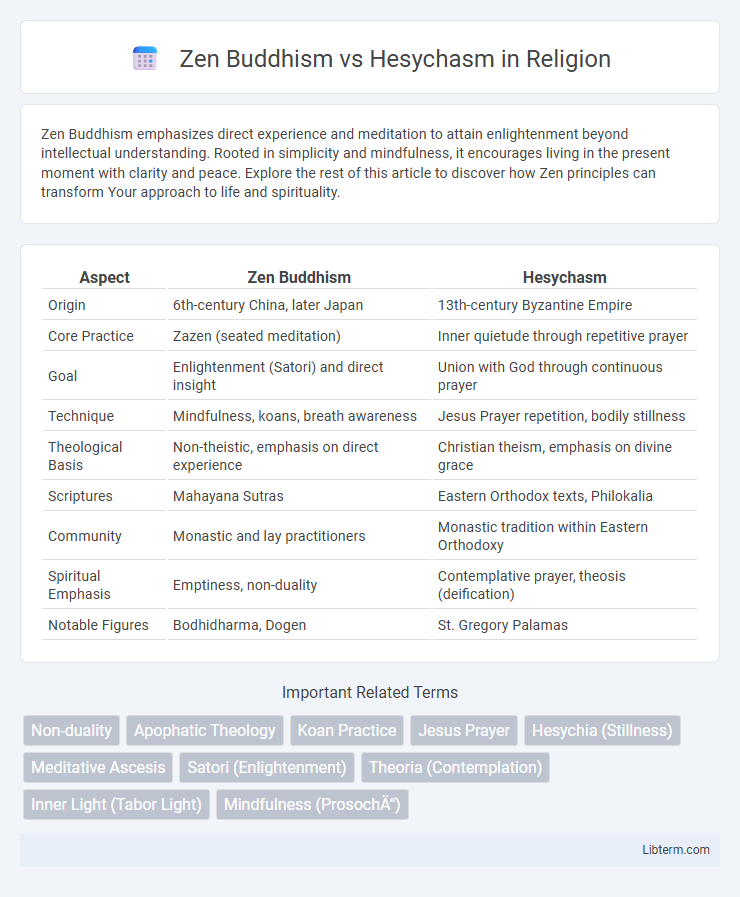Zen Buddhism emphasizes direct experience and meditation to attain enlightenment beyond intellectual understanding. Rooted in simplicity and mindfulness, it encourages living in the present moment with clarity and peace. Explore the rest of this article to discover how Zen principles can transform Your approach to life and spirituality.
Table of Comparison
| Aspect | Zen Buddhism | Hesychasm |
|---|---|---|
| Origin | 6th-century China, later Japan | 13th-century Byzantine Empire |
| Core Practice | Zazen (seated meditation) | Inner quietude through repetitive prayer |
| Goal | Enlightenment (Satori) and direct insight | Union with God through continuous prayer |
| Technique | Mindfulness, koans, breath awareness | Jesus Prayer repetition, bodily stillness |
| Theological Basis | Non-theistic, emphasis on direct experience | Christian theism, emphasis on divine grace |
| Scriptures | Mahayana Sutras | Eastern Orthodox texts, Philokalia |
| Community | Monastic and lay practitioners | Monastic tradition within Eastern Orthodoxy |
| Spiritual Emphasis | Emptiness, non-duality | Contemplative prayer, theosis (deification) |
| Notable Figures | Bodhidharma, Dogen | St. Gregory Palamas |
Introduction: Exploring Zen Buddhism and Hesychasm
Zen Buddhism emphasizes direct experiential insight through meditation practices such as zazen, aiming to attain satori or sudden enlightenment. Hesychasm, a mystical tradition within Eastern Orthodox Christianity, centers on prayerful stillness and the repetitive invocation of the Jesus Prayer to achieve inner quiet and divine union. Both spiritual paths prioritize contemplative silence and experiential knowledge but differ fundamentally in their theological frameworks and methods of practice.
Historical Origins and Development
Zen Buddhism originated in China during the Tang dynasty (618-907 CE) as Chan Buddhism, emphasizing direct experience and meditation (zazen) rooted in Indian Mahayana teachings and Daoist influences. Hesychasm developed in the Eastern Orthodox Christian tradition by the 14th century, particularly through the teachings of Saint Gregory Palamas, emphasizing inner stillness and repetitive prayer (Jesus Prayer) for divine union. Both traditions evolved distinct meditative practices, shaping spiritual disciplines that influenced East Asian and Byzantine religious landscapes respectively.
Core Philosophical Foundations
Zen Buddhism and Hesychasm both emphasize direct experiential knowledge but differ in their core philosophical foundations; Zen centers on sudden enlightenment (satori) through meditation (zazen) and the realization of non-duality and emptiness (sunyata) in Mahayana Buddhism. Hesychasm, rooted in Eastern Orthodox Christianity, focuses on inner stillness and repetitive prayer (the Jesus Prayer) to achieve theosis, a transformative union with God. While Zen highlights the impermanence and interconnectedness of all phenomena, Hesychasm stresses the uncreated energies of God as the path to spiritual purification and divine communion.
Key Spiritual Practices
Zen Buddhism emphasizes zazen meditation, where practitioners engage in seated meditation to cultivate mindfulness and direct insight into the nature of existence. Hesychasm centers on the repetitive Jesus Prayer, aiming to achieve inner stillness (hesychia) and communion with divine light through contemplative prayer. Both traditions prioritize disciplined spiritual exercises fostering profound experiential awareness and transformation.
Meditation Techniques: Zazen vs. Hesychast Prayer
Zazen, the core meditation practice in Zen Buddhism, emphasizes seated meditation with focused breathing and mindful awareness to attain direct insight into one's true nature. Hesychasm centers on repetitive Jesus Prayer, combining controlled breathing with inner stillness to achieve relentless communion with God and spiritual tranquility. Both techniques cultivate deep concentration and the transformation of consciousness but diverge in their theological aims and ritual frameworks.
Role of Mindfulness and Inner Silence
Zen Buddhism emphasizes mindfulness through meditation practices like Zazen, cultivating a present-moment awareness that fosters inner silence and direct experience of reality. Hesychasm centers on the repetitive Jesus Prayer and contemplative stillness, aiming to quiet the mind and achieve union with divine light through inner silence. Both traditions use disciplined mental focus and silence to transcend ordinary consciousness, but Zen prioritizes non-dual awareness while Hesychasm seeks a personal encounter with God.
Symbolism and Iconography
Zen Buddhism emphasizes simplicity and direct experience, often using zen gardens, enso circles, and calligraphy as symbols representing enlightenment, emptiness, and the cyclical nature of existence. In contrast, Hesychasm employs rich iconography featuring Christ Pantocrator, the Virgin Mary, and numerous saints, symbolizing divine light and the uncreated energy of God through detailed, contemplative imagery. Both traditions use symbolism and iconography to facilitate spiritual focus, but Zen favors minimalistic and abstract forms while Hesychasm embraces intricate, theologically charged visuals.
Paths to Enlightenment: Satori and Theosis
Zen Buddhism emphasizes the sudden awakening known as Satori, a direct, non-conceptual realization of one's true nature achieved through meditation (zazen) and mindful practice. Hesychasm centers on Theosis, the transformative process of becoming united with God through continuous prayer, asceticism, and the hesychast method of inner silence. Both paths prioritize experiential knowledge and spiritual purification but diverge in method and theological framework, with Satori rooted in non-dual awareness and Theosis grounded in theistic union.
Community, Monasticism, and Daily Life
Zen Buddhism emphasizes communal meditation (zazen) within monasteries where monks engage in rigorous schedules of sitting, chanting, and work practice (samu), fostering harmony and mindfulness in daily life. Hesychasm centers on solitary prayer and the repetitive Jesus Prayer, primarily practiced by Eastern Orthodox monks in monastic settings that value seclusion and silence to achieve inner stillness. Both traditions structure monastic life around disciplined routines, yet Zen incorporates active communal engagement, whereas Hesychasm prioritizes personal contemplative prayer within a quiet, ascetic community.
Points of Convergence and Distinction
Zen Buddhism and Hesychasm converge in their emphasis on contemplative silence and direct experiential realization of ultimate reality, using meditation as a core practice to transcend ordinary consciousness. Zen employs zazen (seated meditation) to cultivate mindfulness and sudden insight into the nature of existence, while Hesychasm utilizes repetitive Jesus Prayer and inner stillness to achieve hesychia, a state of divine quietude and union with God. Distinctively, Zen is rooted in Mahayana Buddhist philosophy emphasizing emptiness (shunyata) and non-duality, whereas Hesychasm is grounded in Eastern Orthodox Christian theology focusing on theosis and the uncreated light of God.
Zen Buddhism Infographic

 libterm.com
libterm.com